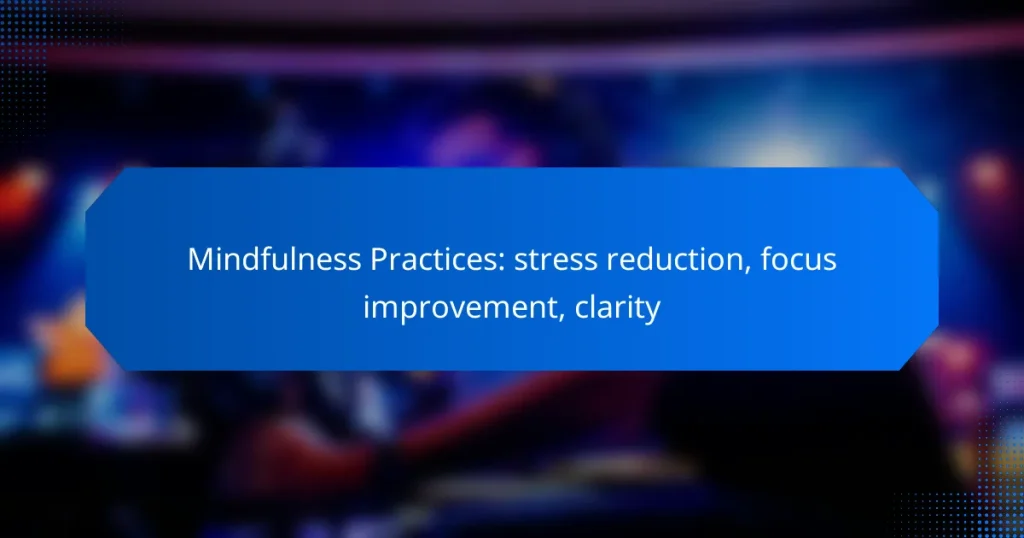Mindfulness practices are powerful tools for reducing stress and enhancing mental clarity. By fostering a heightened awareness of the present moment, these techniques enable individuals to manage their thoughts and emotions effectively. As a result, practitioners can experience improved focus and a calmer state of mind, leading to better decision-making and overall well-being.

How can mindfulness practices reduce stress?
Mindfulness practices can significantly reduce stress by promoting relaxation and enhancing awareness of the present moment. These techniques help individuals manage their thoughts and emotions, leading to a calmer state of mind.
Mindfulness meditation
Mindfulness meditation involves focusing on the breath and observing thoughts without judgment. This practice helps cultivate a sense of calm and reduces the impact of stressors by training the mind to remain present.
To start, find a quiet space, sit comfortably, and concentrate on your breathing for 5 to 10 minutes daily. Gradually increase the duration as you become more comfortable with the practice.
Breathing exercises
Breathing exercises are effective for stress reduction by activating the body’s relaxation response. Techniques such as deep belly breathing can lower heart rate and promote a sense of tranquility.
One simple method is the 4-7-8 technique: inhale for 4 seconds, hold for 7 seconds, and exhale for 8 seconds. Repeat this cycle for several minutes to help alleviate tension.
Body scan techniques
Body scan techniques involve mentally scanning the body for areas of tension and consciously relaxing them. This practice enhances body awareness and helps release physical stress that may be contributing to overall anxiety.
To perform a body scan, lie down comfortably and focus on each part of your body, starting from your toes and moving up to your head. Spend a few moments on each area, consciously relaxing any tension you feel.
Guided imagery
Guided imagery uses visualization to create a peaceful mental environment, helping to reduce stress. By imagining calming scenes, individuals can shift their focus away from stressors and promote relaxation.
To practice guided imagery, find a quiet space, close your eyes, and visualize a serene place, such as a beach or forest. Engage all your senses to enhance the experience, imagining the sounds, smells, and sensations of that environment.
Nature immersion
Nature immersion involves spending time in natural settings, which can lower stress levels and improve overall well-being. Studies suggest that being in nature can reduce cortisol levels and enhance mood.
Try to spend at least 20 to 30 minutes outdoors in a green space or park each week. Activities like walking, hiking, or simply sitting in nature can provide significant stress relief and improve mental clarity.
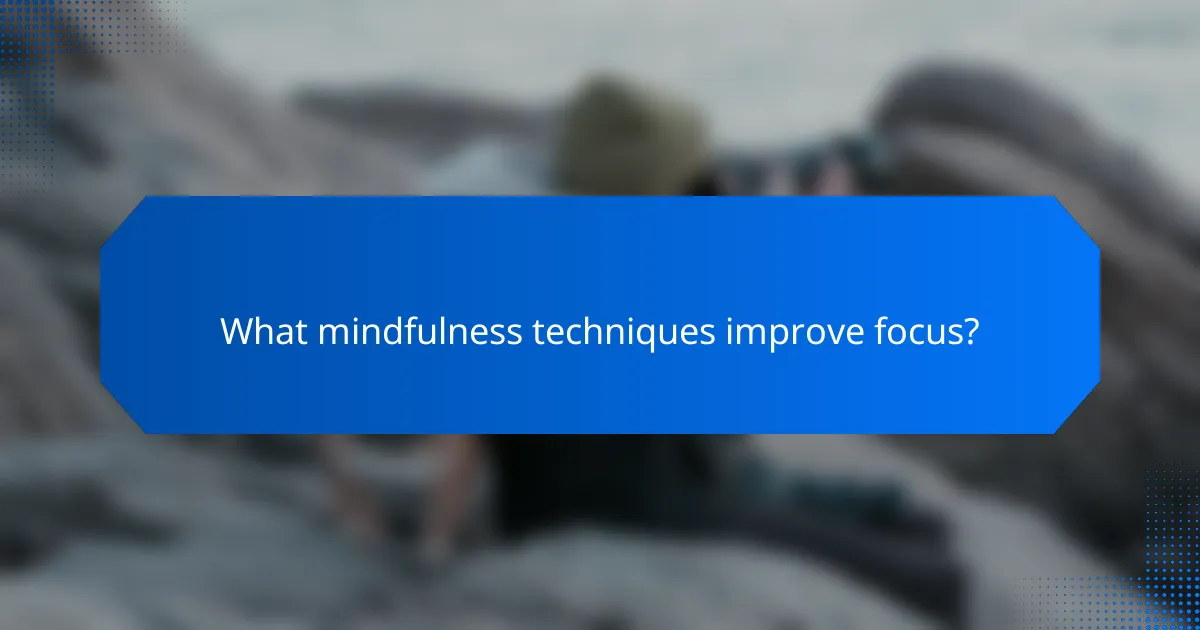
What mindfulness techniques improve focus?
Mindfulness techniques that enhance focus include practices that train the mind to concentrate on the present moment. These methods help reduce distractions and improve mental clarity, leading to better performance in various tasks.
Focused attention meditation
Focused attention meditation involves concentrating on a single object, thought, or sensation, such as the breath. This practice helps to strengthen the mind’s ability to maintain focus by repeatedly bringing attention back to the chosen point of concentration.
To get started, find a quiet space and sit comfortably. Set a timer for 5 to 10 minutes, close your eyes, and focus on your breathing. If your mind wanders, gently redirect your attention back to your breath without judgment.
Mindful walking
Mindful walking is a practice that combines movement with awareness, allowing you to focus on the sensations of walking. This technique encourages you to pay attention to each step, the feeling of your feet on the ground, and your surroundings.
To practice mindful walking, choose a quiet path and walk slowly. Focus on the rhythm of your steps and the sensations in your legs and feet. If your mind drifts, acknowledge the thoughts and return your focus to the act of walking.
Journaling
Journaling can improve focus by helping you clarify thoughts and emotions, reducing mental clutter. Writing down your thoughts allows you to process information and prioritize tasks, which can enhance concentration.
Set aside time each day to write about your experiences, thoughts, or goals. Aim for 10 to 15 minutes of free writing without worrying about grammar or structure. This practice can help clear your mind and improve your focus on important tasks.
Single-tasking strategies
Single-tasking strategies involve focusing on one task at a time instead of multitasking. This approach helps to minimize distractions and enhances overall productivity by allowing for deeper concentration on each individual task.
To implement single-tasking, create a prioritized to-do list and tackle one item at a time. Limit distractions by turning off notifications and setting specific time blocks for each task. This method can significantly improve your ability to focus and complete tasks efficiently.
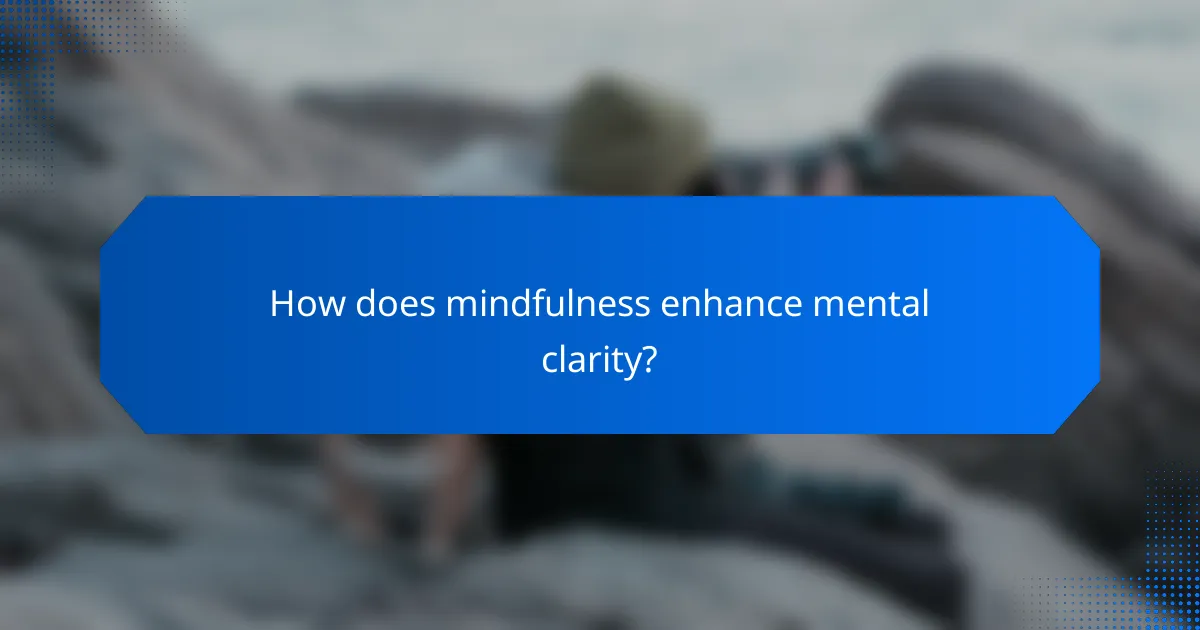
How does mindfulness enhance mental clarity?
Mindfulness enhances mental clarity by promoting awareness and focus on the present moment. This practice helps to reduce distractions and mental clutter, allowing for clearer thinking and improved decision-making.
Mindful observation
Mindful observation involves paying close attention to your surroundings and experiences without judgment. By focusing on details such as sights, sounds, and sensations, you can cultivate a deeper awareness that sharpens your mental clarity.
To practice mindful observation, find a quiet space and take a few moments to notice your environment. Identify specific elements, like the color of leaves or the sound of wind, and let go of any distractions. This simple exercise can enhance your ability to concentrate on tasks.
Reflective practices
Reflective practices, such as journaling or meditation, encourage deeper thinking about your thoughts and feelings. Engaging in regular reflection can help you identify patterns in your thinking, leading to greater clarity and insight.
Consider setting aside time each day to write in a journal about your experiences and emotions. This can help you process information and clarify your thoughts, making it easier to focus on what truly matters.
Visualization techniques
Visualization techniques involve creating mental images to enhance focus and clarity. By picturing your goals or desired outcomes, you can align your thoughts and actions towards achieving them.
To use visualization effectively, spend a few minutes each day imagining yourself successfully completing a task or reaching a goal. This practice can help reinforce your intentions and improve your mental clarity as you work towards your objectives.
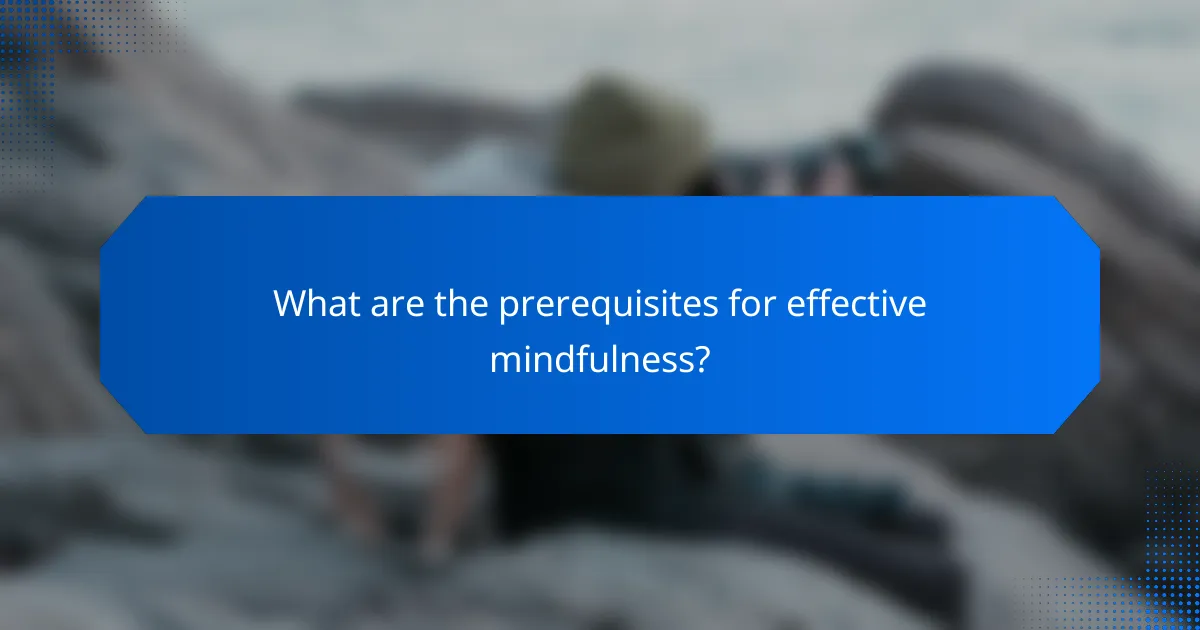
What are the prerequisites for effective mindfulness?
Effective mindfulness requires a few essential prerequisites, including a dedicated space for practice and a regular schedule. These elements help create an environment conducive to focus and clarity, allowing individuals to engage more deeply with their mindfulness techniques.
Creating a dedicated space
Establishing a dedicated space for mindfulness practice is crucial for minimizing distractions and fostering a sense of calm. This space should be quiet, comfortable, and free from interruptions, ideally equipped with items that promote relaxation, such as cushions or soft lighting.
Consider personalizing this area with elements that resonate with you, like plants, calming artwork, or scented candles. The goal is to create an inviting atmosphere that encourages regular practice and enhances your overall mindfulness experience.
Setting a regular schedule
Setting a regular schedule for mindfulness practice significantly improves consistency and effectiveness. Aim for short sessions, ideally ranging from 5 to 30 minutes, depending on your comfort level and availability. Regularity helps build a habit and reinforces the benefits of mindfulness over time.
Choose specific times during your day that work best for you, such as early mornings or evenings. Consistency is key, so try to stick to your schedule, but be flexible enough to adjust as needed to maintain motivation and engagement.

How to choose the right mindfulness practice for you?
Selecting the right mindfulness practice involves understanding your personal goals and considering how much time you can dedicate to these activities. By aligning your objectives with your available time, you can find a practice that effectively reduces stress, enhances focus, and improves clarity.
Assessing personal goals
Begin by identifying what you want to achieve through mindfulness. Common goals include reducing anxiety, improving concentration, or fostering emotional resilience. Write down your objectives to clarify your intentions and guide your practice.
Different mindfulness techniques cater to various goals. For instance, if stress reduction is your primary aim, practices like guided meditation or deep breathing exercises may be beneficial. In contrast, if you seek to enhance focus, consider mindfulness-based cognitive therapy or concentration exercises.
Considering time availability
Your available time significantly influences which mindfulness practices you can realistically incorporate into your routine. Assess how much time you can dedicate daily or weekly, whether it’s a few minutes or several hours.
For those with limited time, short practices like five-minute breathing exercises or quick body scans can be effective. If you have more flexibility, longer sessions such as hour-long meditations or retreats may provide deeper benefits. Aim for consistency, even if it means starting with just a few minutes each day.
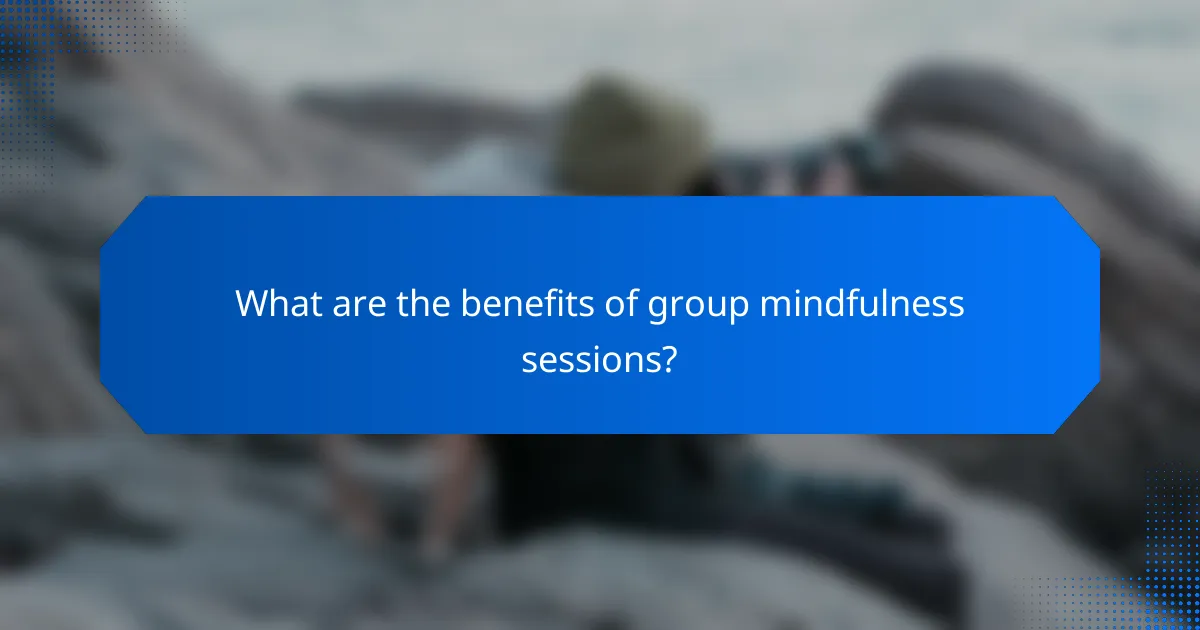
What are the benefits of group mindfulness sessions?
Group mindfulness sessions offer numerous benefits, including enhanced stress reduction, improved focus, and greater mental clarity. Participating in a group setting fosters a sense of community and accountability, which can deepen the mindfulness experience.
Enhanced Stress Reduction
Group mindfulness sessions can significantly lower stress levels by promoting relaxation and emotional regulation. When individuals practice mindfulness together, they often feel more supported, which can lead to a greater sense of calm and well-being.
Research suggests that group settings can amplify the effects of mindfulness practices, making it easier to let go of stressors. Techniques such as guided meditations and collective breathing exercises can help participants manage anxiety more effectively.
Improved Focus
Engaging in group mindfulness activities can enhance focus and concentration. The shared commitment to mindfulness helps individuals stay present and attentive, reducing distractions that often arise in solitary practice.
Group sessions often incorporate structured activities, such as mindful listening or partner exercises, which can sharpen attention skills. Regular participation can lead to noticeable improvements in productivity and mental clarity.
Greater Mental Clarity
Group mindfulness sessions can lead to greater mental clarity by encouraging participants to reflect on their thoughts and emotions in a supportive environment. This collective reflection can help individuals gain insights that may be difficult to achieve alone.
Practices like group discussions or sharing experiences can foster deeper understanding and clarity. Participants often leave sessions feeling more centered and equipped to tackle challenges with a clearer mindset.
